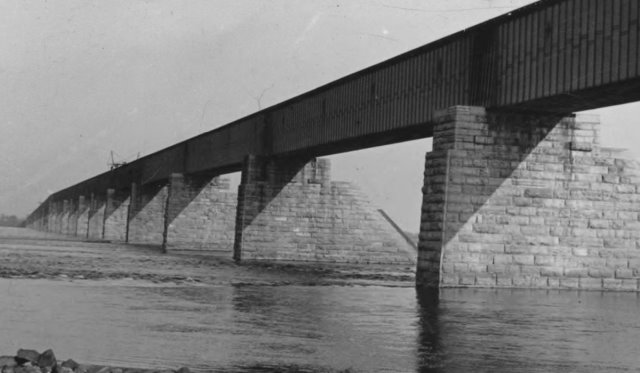We Recommend:
Bach Steel - Experts at historic truss bridge restoration.
BridgeHunter.com Phase 1 is released to the public! - Visit Now
Conwy Railway Bridge (Pont Rheilffordd Conwy)
Conwy Tubular Bridge

Primary Photographer(s): Nathan Holth
Bridge Documented: May 12, 2018
Railroad (Network Rail, North Wales Main Line) Over River Conwy (Afon Conwy)
Wales (Cymru): Conwy, Wales (Cymru): United Kingdom
1849 By Builder/Contractor: William Evans and Engineer/Design: William Fairbairn, E. Hodgkinson, and Robert Stephenson
1899
312.0 Feet (95.1 Meters)
463.0 Feet (141.1 Meters)
Not Available
3 Main Span(s)
Not Applicable

View Information About HSR Ratings
Bridge Documentation
View Historical Books: Tubular and Other Iron Girder Bridges (1st Edition and Third Edition)
View Historical Book: General Description of the Britannia and Conway Tubular Bridges
View Historical Book: An Account of the Construction of the Britannia and Conway Tubular Bridges
View Historical Book: The Britannia and Conway Tubular Bridges
This bridge enjoys a unique and iconic setting next to beautiful Castle Conwy and next to two other historic bridges. This location features the Conwy Railway Bridge, the Conwy Suspension Bridge, and the Conwy Road Bridge.
This wrought iron bridge was constructed at a time when wrought iron (also called malleable iron at the time) was a new material in terms of bridge construction. It was so new that cast iron would continue to be used in the construction of metal bridges for decades after this bridge was built before wrought iron (and its successor, steel) took its place as the dominant material in metal bridge construction.
This extremely unusual type of plate girder bridge, which features very tall girders that have overhead bracing, forming a giant hollow tube of riveted iron, was known as a "tubular bridge." Several examples were built, however this is the only remaining example. It also was one of the first examples built. An incredibly long example, the Victoria Bridge, was built in Montreal, Quebec, Canada. The Brittania Bridge was the other famous one in the UK.
The Conwy Railway Bridge is configured as two superstructures (two separate tubes) that sit side by side.
The Conwy Railway Bridge was altered significantly in 1899. At this time, to strengthen the bridge, two piers were added, turning the bridge into the three-span structure seen today. Additional ribs were riveted to the girders, with the largest ribs added directly over the pier, and a lighter rib system was added to the girder sections directly next to the piers. Away from the piers, the girder web appears to remain unaltered and original 1849 materials and design.
Above: Historical plan sheet showing bridge in its original configuration.
Above: Historical photo showing bridge construction. The second prefabricated girder is being floated out to be installed on the bridge.

Above: The Conwy Railway Bridge inspired Robert Stevenson to design the extremely long Victoria Bridge in Monreal, Quebec, Canada as shown here.
Above: The Conwy Railway Bridge inspired Robert Stevenson to design the extremely long Victoria Bridge in Monreal, Quebec, Canada as shown here.
Official Heritage Listing Information and FindingsListed At: Grade I Discussion: Reference Number: 3236 |
![]()
Photo Galleries and Videos: Conwy Railway Bridge (Pont Rheilffordd Conwy)
Bridge Photo-Documentation
Original / Full Size PhotosA collection of overview and detail photos. This gallery offers photos in the highest available resolution and file size in a touch-friendly popup viewer.
Alternatively, Browse Without Using Viewer
![]()
Bridge Photo-Documentation
Mobile Optimized PhotosA collection of overview and detail photos. This gallery features data-friendly, fast-loading photos in a touch-friendly popup viewer.
Alternatively, Browse Without Using Viewer
![]()
Maps and Links: Conwy Railway Bridge (Pont Rheilffordd Conwy)
Coordinates (Latitude, Longitude):
Search For Additional Bridge Listings:
Additional Maps:
Google Streetview (If Available)
GeoHack (Additional Links and Coordinates)
Apple Maps (Via DuckDuckGo Search)
Apple Maps (Apple devices only)
Android: Open Location In Your Map or GPS App
Flickr Gallery (Find Nearby Photos)
Wikimedia Commons (Find Nearby Photos)
Directions Via Sygic For Android
Directions Via Sygic For iOS and Android Dolphin Browser
Ordnance Survey Maps (UK Only)




